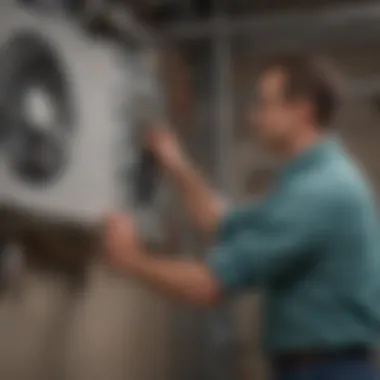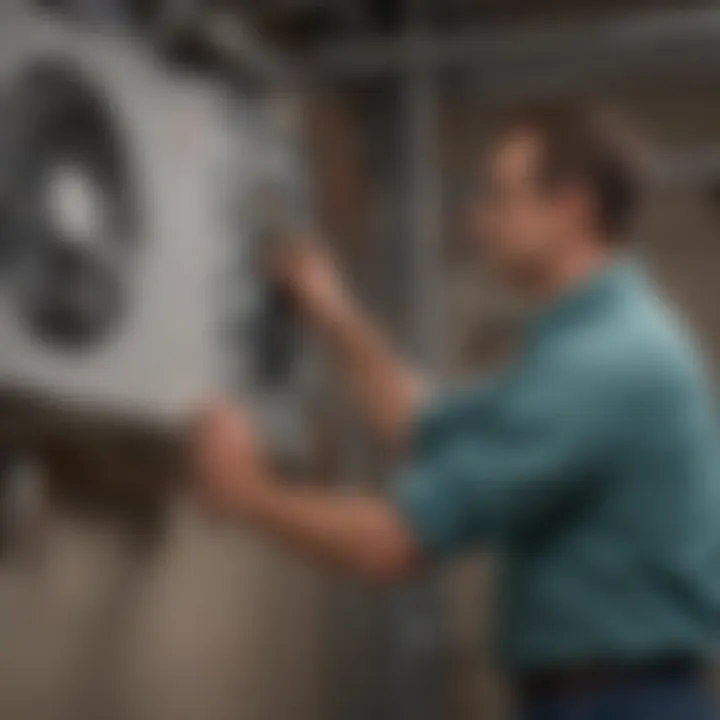Maximizing Efficiency: Reduce Heating and Cooling Costs


Overview of the Topic
In the landscape of personal finance, keeping an eye on energy expenses is becoming increasingly crucial. Heating and cooling costs form a substantial chunk of the average household budget, often leading to financial strain during peak seasons. Understanding what contributes to these costs and how to manage them can have a notable impact not only on monthly expenses but also on overall financial well-being.
At its core, maximizing efficiency in heating and cooling refers to enhancing the performance of systems designed to regulate indoor climates. This can include optimizing existing setups or making necessary investments in more efficient technology. The importance of this practice cannot be overstated — it stretches beyond mere cost savings. There’s also an environmental dimension as reducing energy consumption directly contributes to decreased carbon footprints and aligns with broader sustainability efforts.
Key benefits stemming from lowering heating and cooling costs include:
- Financial savings: Immediate reductions in energy bills are often achievable through simple adjustments.
- Increased comfort: Efficient systems result in more consistent and pleasant indoor environments.
- Asset value enhancement: Properties with advanced energy-efficient systems can command higher resale values.
Understanding these factors presents homeowners with a major opportunity to adopt various strategies aimed at enhancing energy efficiency. The following sections will delve deeper into practical methods and technological advancements that can be employed to maximize energy savings.
Exploring Strategies and Tips
Practical Tips for Implementation
Adopting changes in daily routines and behaviors can create an environment where energy is conserved more readily. Some practical tips include:
- Embrace habitual adjustments like setting thermostats lower in the winter and warmer in summer.
- Incorporate smart devices that allow remote monitoring and control of heating and cooling systems. Smart thermostats can learn user habits and adjust accordingly.
- Regular maintenance ensures systems are running efficiently, thus prolonging their lifespan and maintaining their energy efficiency.
Strategies for Effective Management
A well-balanced plan not only optimizes energy consumption but may incorporate financial aspects, too. Homeowners can benefit by:
- Conducting an energy audit, either personally or professionally, to identify where heat loss may occur.
- Investing in insulation improvements, particularly in attics and walls.
- Utilizing window treatments like thermal curtains that help regulate indoor temperatures.
By implementing these strategies, individuals can sustain a more effective energy management approach.
Case Studies and Examples
Real-Life Examples Demonstrating Successful Application
It’s always insightful to explore how actual households have navigated their quest for energy efficiency. One example is the Garcia family, who invested in high-efficiency heat pumps after a comprehensive audit highlighted their outdated system.
Another case is that of the Nguyen household, who opted for smart home devices. With the installation of smart thermostats and sensors, they reported a 20% decrease in heating bills over a single winter.
Case Studies Highlighting Pitfalls to Avoid
While many strategies are successful, it’s essential to recognize pitfalls. For instance, the Smiths upgraded their HVAC system but overlooked proper duct sealing. This meant much of their investment went to waste, as system efficiency was undermined by air leaks.
"Upgrading without ensuring existing systems are optimized can be a costly oversight."
Comparison of Financial Products
Using Financial Tools to Fund Improvements
When considering upgrades for energy efficiency, various financial products can facilitate changes. Home equity loans, personal loans, and energy efficiency mortgages are some options homeowners might explore. An analysis of these includes:
- Home Equity Loan: These often provide lower interest rates but require considerable collateral.
- Personal Loan: While these can be unsecured, the associated interest rates can be high.
- Energy Efficiency Mortgages: These blend energy improvements into the mortgage, promoting cash flow improvements with potential rebates or credit.
Each option has its own pros and cons, which must be evaluated to choose what's most suitable for individual financial circumstances.
Expert Insights and Recommendations
Insights from Financial Experts in the Field
Experts in both finance and energy efficiency recommend coupling financial planning with energy audits. The rationale is straightforward — knowing your home's specific needs allows for tailored financial solutions.
Recommendations for Leveraging the Topic Effectively
Homeowners should focus not only on immediate cost-cutting measures but also on the long-term implications of their choices in heating and cooling systems. Consider those improvements as investments rather than expenses, as it leads to healthier finances in the long run.
Understanding the Basics of Heating and Cooling Costs
Understanding the dynamics of heating and cooling costs is crucial for anyone looking to manage their expenses effectively. Energy expenditures for heating and cooling can constitute a substantial portion of a household's budget, often overshadowing spending in other areas. To gain control over these expenses, it is necessary to first comprehend how these systems work and what drives their costs.
Heating and cooling systems play a pivotal role in maintaining a comfortable living environment. Grasping how they function allows homeowners to appreciate the factors that influence their energy consumption and ultimately their bills. Moreover, understanding the specific elements that drive energy prices helps individuals make informed decisions about energy consumption and conservation efforts.
In this context, recognizing this foundational knowledge is not merely an academic exercise; it's about empowering homeowners to navigate the labyrinth of energy efficiency measures and cost-saving strategies. An informed approach can lead to significant reductions in energy bills while enhancing comfort and sustainability.
How Heating and Cooling Systems Function
Every heating and cooling system operates on the principles of energy transfer, whether it’s through the conduction, convection, or radiation of heat. Heating systems, often powered by gas, oil, or electricity, work by generating warmth through a furnace or heat pump, circulating the heated air throughout the home via ducts or radiators.
Cooling systems, predominantly central air conditioning or heat pumps, function by removing heat from indoor spaces and expelling it outside. The effectiveness of these systems hinges on their proper maintenance and the characteristics of the home – insulation, window quality, and design.
For instance, a well-insulated home retains heat better in winter and remains cooler in summer, translating to lower energy costs. Homeowners who understand these dynamics can adjust their lifestyles and investments in home improvements, leading to enhanced efficiency and less financial drain.
Factors Influencing Energy Prices
Energy prices are not static; they fluctuate due to various factors, significantly impacting the cost of heating and cooling a home. Here are some key influences worth noting:
Seasonal Variations


Seasonal fluctuations are perhaps the most apparent factor affecting energy costs. Each season brings different demands for heating and cooling that can drastically affect prices. During the winter months, heating demands spike, often leading to increased prices for fuel sources like natural gas and heating oil. Conversely, the hot summer months can see soaring electricity usage for air conditioning, which can inflate electricity rates.
Major characteristics of seasonal variations include the marked differences in temperature and weather patterns that affect how much energy a household consumes. This is why, during especially cold winters or scorching summers, individuals may find energy costs climbing significantly. While they are a normal aspect of energy usage, understanding these patterns can help homeowners plan for higher bills and adjust their usage accordingly, such as setting back thermostats during peak demand periods.
Geographical Influences
Geographical influences play a vital role in energy prices. Regions with extreme temperatures, whether hot or cold, often face higher energy costs as users struggle to maintain comfortable conditions within their homes. Furthermore, areas that depend heavily on imported energy sources may experience additional costs compared to those with access to local, renewable energy alternatives.
One key characteristic of geographical influences is how regional energy resources vary, affecting both availability and pricing. For instance, coastal areas may benefit from wind energy, while mountainous regions might harness hydroelectric power more efficiently. The unique features of each geographical area can provide insights into potential savings by choosing appropriate energy sources that align with local conditions.
Market Fluctuations
Market fluctuations encompass broader economic factors and global events that can influence energy prices. For instance, geopolitical instability in oil-producing regions can lead to spikes in fuel prices, which in turn affects heating and cooling costs. Additionally, changes in environmental regulations, shifts to greener energy solutions, and technological advancements can create volatility in the energy market.
An essential characteristic of market fluctuations is their unpredictability. This unpredictability invites challenges for consumers trying to anticipate energy costs. However, consumers can mitigate some effects by staying informed about market trends and adjusting their usage patterns accordingly. By being proactive, homeowners can better navigate the ebb and flow of energy prices, harnessing strategies to minimize impacts on their heating and cooling bills.
Conducting a Home Energy Audit
A home energy audit is much like a thorough check-up for your abode. It serves to diagnose inefficiencies and pinpoint sources of energy loss, making it an essential step in reducing heating and cooling costs. Understanding how your home uses energy enables you to make informed decisions. It can lead to not only immediate savings but long-term benefits as well.
One major benefit of an energy audit is identifying potential areas for improvement, which lays the groundwork for strategies that significantly cut energy expenses. Beyond just the financial aspect, an energy audit fosters a more comfortable living environment by reducing drafts and enhancing temperature consistency.
Key considerations when conducting an energy audit include the scope of the audit, the areas to inspect, and whether to engage professionals or take a DIY approach. Each of these can affect the thoroughness of the assessment and eventual savings.
Identifying Energy Loss Points
Windows and Doors
Windows and doors are often the primary culprits for energy inefficiencies in homes. A substantial amount of heat can escape through older or improperly sealed windows and doors, making them a focus during an energy audit. Their key characteristic is vulnerability—they're often made of glass or materials that can easily let air pass through if not properly installed.
Thus, the right choice for upgrading can significantly improve comfort and reduce costs. Energy-efficient windows, for instance, are designed to minimize heat loss while allowing natural light into your home. The unique features of these includes double or triple glazing and Low-E coatings, which reflect heat back into the home without sacrificing visibility.
However, the disadvantage of upgrading windows is the upfront costs, which can be prohibitive for some homeowners. When considering this option, weigh the long-term benefits against the initial investment.
Insulation Quality
Insulation acts as a barrier, slowing heat transfer. This means that better insulation can keep the warmth in during winter and relative coolness during summer, enhancing your overall energy efficiency. The key characteristic here is that insulation quality directly correlates with energy savings.
High-quality insulation, like spray foam or fiberglass batt, work wonders in cutting down your reliance on heating and cooling systems. It effectively controls indoor temperatures while preventing exhausting energy expenditures. Unique features of insulation include its R-value—this measures resistance to heat flow and is crucial in determining effectiveness.
On the downside, selecting the wrong types or improperly installing insulation can lead to voided warranties or ineffective solutions, sometimes creating even worse energy loss if not done correctly. Proper evaluation should be undertaken when thinking about insulation alternatives.
Ductwork Integrity
Ductwork is the invisible lifeline of your heating and cooling system; when it’s leaking or poorly insulated, your investment in energy-efficient equipment can feel like throwing money down the drain. The critical aspect lies in ductwork integrity—if your ducts are significanty compromised, conditioned air may very well be escaping into uninhabitable spaces.
A well-maintained duct system can lead to increased efficiency and smoother airflow. Regular inspections can help identify leaks or blockages that might otherwise go unnoticed. One unique feature is that many duct-cleaning services also provide sealing, which can boost the overall performance of your HVAC system, making it a popular choice for many homeowners.
However, one must consider that cleaning and maintaining ducts can add additional costs to your budget, and it's generally recommended only for systems that show clear signs of inefficiency or are older.
Utilizing Professional Services vs. DIY Audits
Deciding between using professional services or conducting a DIY audit can be a balancing act. Engaging professionals offers an advantage in thoroughness and expertise, as they are equipped with specialized tools and knowledge to uncover problems you may not spot yourself. In addition, most pros will provide a detailed report along with actionable suggestions specific to your home.
On the flip side, a DIY audit can save you dollars, allowing you to put those funds toward repairs or preventive measures. By using simple methods such as visual inspections or online energy calculators, you may successfully identify major energy drains. However, the accuracy and thoroughness might not match that of a professional audit.
Improving Home Insulation
When it comes to maximizing efficiency in energy consumption, improving home insulation plays a crucial role. Proper insulation acts as a barrier, minimizing the transfer of heat between the indoors and outdoors. This not only ensures a comfortable living environment but also significantly reduces energy bills associated with heating and cooling systems. A well-insulated home allows you to rely less on HVAC systems, leading to lower energy consumption and reduced greenhouse gas emissions.
Materials that Enhance Insulation
Fiberglass
Fiberglass stands out as a popular choice for insulation due to its effective thermal performance and relative affordability. One significant characteristic of fiberglass is its lightweight nature, which makes it easy to handle and install. Furthermore, it is non-combustible, meaning it won't ignite easily, adding a layer of safety to your home. The unique feature of fiberglass is its ability to trap air within its fibers, enhancing its insulating properties. In terms of advantages, fiberglass insulation is resistant to moisture, which helps in preventing mold growth. However, it can irritate the skin and lungs during installation, necessitating proper protective gear.
Spray Foam
Spray foam insulation presents another robust option for improving energy efficiency. One of its key characteristics is its ability to expand upon application, filling in gaps and cracks that might let air escape. This unique feature not only provides a tight seal but also offers superior insulation compared to traditional materials. Spray foam is known for its high R-value, which measures its thermal resistance. Its advantages include excellent energy savings and creating a barrier against moisture and pests. On the downside, it can be more expensive than other insulation materials and requires professional installation to ensure effectiveness.
Reflective Barriers
Reflective barriers differ from traditional insulation materials by reflecting heat instead of absorbing it. This innovative approach is particularly effective in warmer climates, where it minimizes heat gain from solar radiation. The key characteristic of reflective barriers is their shiny, metallic surface that bounces heat away, keeping interiors cooler. The unique feature of these barriers is that they can be installed in attics or against roofs, qhelping to lower cooling costs during the blistering summer months. While widely beneficial, it's worth noting reflective barriers work best in conjunction with other insulation types, as they do not provide insulation on their own.
Sealing Air Leaks
A significant aspect of improving home insulation revolves around sealing air leaks. Many homeowners might not realize that unnoticed gaps and cracks around windows, doors, and even ducts can account for a substantial loss of conditioned air. By thoroughly inspecting and sealing these leaks, you can effectively enhance your home’s overall energy efficiency. Various materials are available for sealing, including caulk, weatherstripping, and foam sealants, providing homeowners with plenty of options. Identifying and addressing air leaks not only protects against drafts but also heightens the performance of heating and cooling systems, ultimately leading to greater comfort and cost savings.
Modern Heating and Cooling Solutions
In the quest to slash heating and cooling costs, modern solutions can be a game-changer. With technology constantly evolving, it’s crucial to stay updated on the latest innovations that not only promise energy efficiency but also aim to enhance comfort in your home. These systems often integrate advanced features, helping homeowners make choices that save money while being environmentally conscious.
Choosing Energy-Efficient Systems
Heat Pumps


Heat pumps are increasingly touted as a smart solution for home heating and cooling. Unlike traditional heating systems that generate heat, heat pumps transfer it from one place to another. This method proves particularly effective in moderate climates, allowing for efficient energy use year-round. One of the key characteristics of heat pumps is their ability to provide both heating and cooling, making them versatile.
The unique feature of heat pumps is their thermodynamic cycle. When it's warm, they suck heat from the home and release it outside. Conversely, during colder months, they draw heat from the external environment, however chilly it may be, and transfer it indoors. The primary advantage lies in their efficiency; heat pumps can deliver three times more heat energy than the electrical energy they consume, translating into lower energy bills.
However, there are disadvantages worth noting. They may struggle to function efficiently in extreme temperatures, leading to the necessity of supplemental heating. Overall, understanding your climate conditions is vital before investing in a heat pump.
Smart Thermostats
Smart thermostats represent a significant leap in energy-saving technology. Their main advantage is programmability; homeowners can set schedules to adjust temperatures based on their routine. Not only does this save energy, but it also enhances home comfort by ensuring that your living environment aligns with your daily activities.
The key characteristic that sets smart thermostats apart is their connectivity features. These devices can be controlled remotely via a smartphone app, allowing you to make adjustments whether you're cozied up on the couch or away at work. Moreover, they learn your habits over time and will start optimizing energy use automatically.
A notable disadvantage can be the initial cost, as smart thermostats tend to be pricier than traditional ones. But when you consider the potential savings over time, many users find the investment worth it. Your energy bills could drop significantly, making it a win-win situation.
Variable Refrigerant Flow Systems
Variable Refrigerant Flow, commonly referred to as VRF systems, is another advanced technology making waves in the realm of energy efficiency. These systems offer personalized comfort through their capability to control individual zones within a home. By adjusting refrigerant flow to different areas, VRF systems ensure that every corner of your home receives optimal heating or cooling as needed, without wasting energy.
The key characteristic of VRF systems is their ability to utilize a single outdoor unit to connect multiple indoor units. This modularity allows for greater flexibility in system design and installation. Also, the unique inverter-driven compressors adapt the refrigerant flow in real time, contributing to overall improved energy use.
However, while VRF systems can be rather efficient, their installation may involve higher upfront costs due to the complexity and installation requirements. Yet, the long-term savings on energy costs often make them a compelling option for homeowners seeking to enhance energy efficiency.
Understanding SEER and AFUE Ratings
The Season Energy Efficiency Ratio (SEER) and Annual Fuel Utilization Efficiency (AFUE) ratings are crucial metrics for assessing the efficiency of heating and cooling systems. SEER includes the cooling output during a typical cooling season divided by the total electric energy input during the same time frame. Higher SEER ratings indicate superior efficiency, meaning lower utility costs for the homeowner.
On the other hand, AFUE is specific to heating systems, measuring the efficiency of a furnace or boiler. A higher AFUE translates to greater energy savings, pushing for a reduced carbon footprint.
In summary, being educated on the various modern heating and cooling solutions along with their operational metrics can help homeowners make informed decisions that align with their goals of energy efficiency and cost reduction. Each option comes with its own set of benefits and considerations, requiring a thorough evaluation relative to one’s unique circumstances.
Optimizing Thermostat Settings
In the journey towards reducing heating and cooling costs, optimizing thermostat settings plays a pivotal role. The HVAC system is the heart of indoor comfort, and the thermostat is its brain. Understanding how to leverage this gadget effectively can lead not only to greater efficiency but also to noticeable reductions in energy bills.
Adjusting Temperature for Efficiency
To maximize efficiency, adjusting the thermostat’s temperature settings is crucial. The U.S. Department of Energy suggests setting your thermostat to 68°F in winter and 78°F in summer. However, these numbers are not written in stone; they serve as starting points. If you can tolerate slightly higher temperatures in summer, try setting it a few degrees warmer. Likewise, lowering it a bit in winter can make a significant difference in energy consumption.
Moreover, consistency matters. Keeping a steady temperature throughout the day prevents your system from overworking. Many homeowners waste energy by frequently adjusting their temperature settings throughout the day due to changing schedules or comfort complaints. When you set it and leave it, your system runs more efficiently. You can also consider using the two-degree rule: for every degree you adjust up in summer or down in winter, you can save a noticeable amount on your energy bill.
Importance of Programmable and Smart Thermostats
Programmable and smart thermostats revolutionize how we manage temperature settings in our homes. These devices are not just flashy gadgets; they are tools designed to reduce costs and enhance convenience. With programmable thermostats, homeowners can set specific times for heating or cooling, effectively managing energy use based on occupancy. For instance, setting the thermostat to lower temperatures when everyone is at work or asleep can yield impressive savings without sacrificing comfort.
Moreover, smart thermostats take this a step further. They learn your habits and adjust accordingly. Imagine returning home from a long day and having your house perfectly warm without having to hover over the thermostat. Some smart models even integrate with mobile apps, allowing adjustments on-the-go or utilizing sensors to detect when someone is home or away, which means less energy wasted.
"Investing in a smart thermostat is like buying yourself a money manager for your home’s energy consumption."
In addition to convenience, many smart thermostats can provide usage reports, helping homeowners understand their consumption patterns. Identifying trends offers valuable insight and prompts further behavior adjustments.
Behavioral Adjustments for Energy Savings
Behavioral adjustments play a pivotal role in reducing heating and cooling costs. Often, people overlook simple changes in their daily habits that can significantly improve energy efficiency. These adjustments not only lead to immediate savings but also foster a more sustainable lifestyle. The beauty of behavioral changes lies in their accessibility; anyone can implement them without needing to invest in costly upgrades or technologies.
Modifying Daily Routines
To begin with, small tweaks in daily routines can yield noticeable results. For instance, consider adjusting your heating and cooling settings based on your schedule. If you're out of the house most of the day, lowering your thermostat during winter or raising it a few degrees in summer can save energy. A few degrees might not seem like much, but over time, it can translate into real savings on your utility bill.
Furthermore, procrastination can be an energy killer. When you delay or forget to adjust your thermostat, you're wasting energy. Establishing a regular routine where you check your settings in the morning and evening can help prevent unnecessary energy loss. Additionally, making it a habit to dress according to the season can reduce reliance on heating and cooling systems. In the colder months, wearing a cozy sweater instead of cranking up the heat can make a world of difference.
Of course, for those getting into the nitty-gritty of energy savings, being mindful about appliance usage is key. Using appliances during off-peak hours, when energy is typically cheaper, can also be a game changer.
Understanding Peak Energy Usage Times
Knowing peak energy usage times can make a significant impact on energy bills. Generally, energy costs spike during periods of high demand, which usually occur in the early evening when many people return home and turn on lights, electronics, and climate control systems simultaneously.
Here are some ways to make the most of this knowledge:
- Plan Energy-Intensive Tasks Wisely: Aim to run dishwashers, laundry machines, or ovens during off-peak hours, when energy consumption rates are lower.
- Limit Use of High-Energy Appliances: If you can hold off using some high-energy appliances until later in the evening or early morning, do it.
- Set Smart Devices: Many modern thermostats and smart home devices can be programmed to adjust automatically during peak periods, optimizing efficiency without requiring constant attention.
Keeping tabs on your utility company’s peak and off-peak hours can provide insights tailored to your specific location. Take a moment to connect with your local energy provider; they often publish information regarding energy usage patterns. As a result, you'll not only contribute to energy conservation but also ensure that you manage your energy costs effectively.
"The simplest changes often lead to the most profound impact."
Maintenance Practices for Efficiency
Maintaining heating and cooling systems is a critical aspect of maximizing energy efficiency. Regular maintenance doesn't just extend the lifespan of these systems; it also ensures that they are operating at peak performance. This section explores two major components of effective maintenance: regular system inspections and the importance of replacing filters, each with its own set of benefits and considerations.
Regular System Inspections
Regular system inspections serve as the backbone of an efficient heating and cooling setup. Schedule these inspections at least once a year, ideally before the onset of the heating or cooling season. This practice unearths potential issues that could lead to inefficiencies down the road.
An inspection typically includes checking the overall system performance, ensuring that all components are functioning as intended, and identifying any early signs of wear or malfunction.
There are multiple benefits to these inspections:
- Preventative Maintenance: This strategy allows for fixing minor issues before they escalate into larger, more costly repairs.
- Performance Optimization: Technicians can fine-tune systems for better energy efficiency, ensuring they consume less energy while delivering optimal comfort.
- Safety Assurance: Regular checks can identify potential safety hazards, such as gas leaks or electrical risks.


Don't wait for a breakdown to prompt an inspection. Instead, approach it with a proactive mindset. In some cases, maintaining a log of inspections not only keeps you on track but can also become a handy tool if you ever plan to sell your home. A well-documented maintenance history can underscore the care you’ve taken with the property.
Importance of Replacing Filters
Replacing filters is often overlooked but is vital for maintaining air quality and system efficiency. Air filters capture dust, pollen, and other pollutants, preventing them from circulating through your home. Clogged filters can significantly hamper system performance. So, it’s crucial to change them regularly—at least every three months, or more frequently if you have pets or live in a dusty area.
Here are some key reasons to prioritize filter replacement:
- Energy Savings: Dirty filters cause systems to work harder to move air. When systems are overworked, they consume more energy, which leads to inflated energy bills.
- Improved Air Quality: New filters effectively trap airborne pollutants, contributing to healthier indoor air. This is especially important for allergy sufferers or anyone with respiratory conditions.
- Extended Equipment Lifespan: Maintaining clean filters lessens the strain on heating and cooling systems, ultimately leading to reduced wear and tear over time.
Remember: The cost of filters is minor compared to the expenses associated with high energy bills or premature system failures.
In summary, embracing regular system inspections and consistently replacing filters can significantly improve the efficiency of your heating and cooling systems. These small yet impactful practices can pave the way for substantial savings in energy costs while also contributing to a more comfortable living environment.
Utilizing Renewable Energy Sources
In a world increasingly aware of climate change and rising energy costs, the significance of utilizing renewable energy sources cannot be overstated. This aspect of energy efficiency is not merely a trend; it represents a paradigm shift in how we think about energy consumption and production. By integrating renewable sources such as solar and wind into our heating and cooling strategies, not only can we reduce our dependency on fossil fuels but also create a more sustainable and cost-effective approach to managing energy demands.
Solar Power Integration for Heating and Cooling
Solar power stands at the forefront of renewable energy adoption, showcasing its ability to revolutionize heating and cooling methods in both residential and commercial settings. The concept is straightforward: harnessing the sun's energy to either generate electricity or provide direct heating.
Benefits of Solar Integration:
- Cost Reduction: Once installed, solar panels can significantly cut down electricity bills. Generating your own power means less reliance on grid electricity, which is subject to price fluctuations.
- Low Maintenance: Compared to traditional heating and cooling systems, solar power systems generally require less upkeep. After initial installation, they can operate efficiently for decades with minimal intervention.
- Environmental Impact: Solar energy is clean. Utilizing it reduces greenhouse gas emissions, helping combat climate change and improve local air quality.
However, before diving head-first into solar energy, several considerations merit attention:
- Initial Costs: Although prices have been steadily declining, the upfront cost of solar panel installation can still be a hurdle for some homeowners.
- Local Climate: The efficiency of solar power depends on geographical location and weather patterns. Areas with prolonged rainy seasons may not see the same benefits as sunnier locales.
Government Incentives for Renewable Energy Use
Beyond personal benefits, government incentives play a crucial role in facilitating the uptake of renewable energy sources. Various state and federal programs aim to encourage homeowners and businesses to adopt green technologies.
- Tax Credits: Many governments provide significant tax credits for installing solar panels or other renewable energy systems. This can substantially lower the financial burden on homeowners.
- Grants and Rebates: Some local authorities offer grants or rebates that supplement the cost of renewable energy installations, making it more financially viable.
- Net Metering Policies: These allow homeowners to sell excess electricity generated back to the grid, providing additional financial incentives and promoting further investment in renewable sources.
Integrating renewable energy, particularly solar, into heating and cooling strategies offers a robust, long-term solution for reducing expenses and enhancing energy efficiency. Coupled with government incentives, it fosters an environment conducive to personal financial savings while promoting environmental stewardship.
"Transforming your home’s energy sources isn’t just wise; it’s a step towards a healthier planet and financial freedom in the long run."
Behavioral Incentives for Family Members
When it comes to reducing heating and cooling costs, engaging the entire household is paramount. Family members play a crucial role in adopting energy-efficient behaviors, as energy consumption is often a collective effort within a home. Behavioral incentives can transform the way everyone approaches energy use, turning it into a shared responsibility rather than a chore. Addressing habits and encouraging participation can lead to significant financial savings on energy bills while fostering a culture of sustainability.
Creating a Family Energy-Saving Plan
A family energy-saving plan isn’t just some pie-in-the-sky idea; it’s a practical roadmap that considers the quirks and preferences of every family member. The process begins with an open discussion about current energy habits. Grab a coffee, sit down together, and perhaps take some time to discuss these key points:
- Assess Current Habits: Start by evaluating how much energy your family typically consumes. Track usage on a monthly basis to identify trends.
- Set Clear Goals: Decide together on realistic goals. Maybe you aim for a 10% reduction in heating and cooling costs or commit to turning off lights when not in use.
- Assign Roles: Making it a team effort can instill a sense of ownership. Assign roles such as a "Temperature Monitor" who adjusts thermostats or a "Light Inspector" who ensures all unused lights are off.
- Incorporate Education: Share statistics about energy savings and environmental impacts. Sometimes just knowing the positive implications can spur action.
This plan is not just a checklist; it's a continuous dialogue among family members. Monthly evaluations and updates can provide necessary motivation and keep the effort in sight.
Encouraging Accountability Among Household Members
Accountability is the glue that keeps this whole energy-saving initiative intact. When individuals feel responsible for their part, it can drive long-term change. Here are a few ways to ensure everyone stays accountable:
- Regular Check-ins: Set up a regular family meeting to discuss progress. This could be a monthly affair where everyone shares successes and challenges. It’s a great way to keep spirits up and adjust the plan if necessary.
- Track and Reward: Create a simple tracking system—maybe a chart on the fridge. If the house meets its energy-saving targets, celebrate with a small treat or outing. This not only boosts morale but encourages continuous participation.
- Collaborative Goals: Involve everyone in the goal-setting process. When individuals contribute to the goals, they’re likely to feel more committed to achieving them.
- Peer Support: Encourage family members to remind each other about habits. A gentle nudge from a sibling or a parent can make a difference, fostering a supportive environment.
"A house that works together, saves together. Make energy efficiency a family affair!"
By implementing these behavioral incentives, families can create an empowered and energy-efficient environment. The combined effort through clear, shared goals and mutual accountability can make a noticeable difference— not just on your energy bills but in the way everyone interacts with energy consumption.
Long-Term Benefits of Energy Efficiency
In the realm of home economics, energy efficiency stands as a critical pillar for both immediate and prolonged financial relief. Beyond the tangible savings seen in your utility bills, the long-term benefits of energy efficiency weave into the fabric of property value and environmental stewardship. When homeowners embrace the principles of energy efficiency, they’re not just keeping costs down; they are investing in a sustainable future.
The significance of this topic cannot be overstated. Energy-efficient homes not only contribute to reducing the overall demand on valuable resources but also promote a lifestyle that fosters responsibility and foresight. For homeowners and prospective buyers alike, understanding these benefits can shape decision-making profoundly.
Cost Benefits Over Time
Over time, the adoption of energy-efficient practices translates into substantial financial benefits. In many cases, initial investments in insulation, energy-efficient appliances, or smart home technology pay for themselves within a reasonable period. Take, for example, the installation of high-efficiency HVAC systems. The upfront cost may give some folks pause, but the savings on energy bills can accumulate quickly, often translating into savings of up to 30% or more annually. These savings can be a game changer for budgets over the years.
In addition to utilities, consider maintenance costs. Energy-efficient systems generally require fewer repairs due to their modern components being built to withstand wear and tear better than older systems, which can be little more than money pits.
Here are some key points that underline cost benefits over time:
- Lower Monthly Bills: A simple change can lead to decreased expenses.
- Tax Incentives: Many governments offer rebates or tax credits for energy-efficient upgrades, further lowering net costs.
- Increased Reliability: Newer systems are less likely to break down, reducing repair expenses.
"Generosity in energy savings makes way for opportunities elsewhere in budgets—whether that's saving for a vacation or paying down debts faster."
Improvements in Home Value
Moreover, investing in energy efficiency can markedly enhance your property’s value. Potential buyers are increasingly attuned to the long-term cost implications of home ownership. Homes touted as energy-efficient often attract higher bids, as buyers view them as a less risky investment.
Improvements can range from energy-efficient windows to solar panel installations, which all contribute to a home's energy consumption profile favorably. Research indicates that homes identified as having energy-efficient features can sell for as much as 10-20% more than similar homes lacking these improvements. As green technology evolves and awareness grows, the market's preference will only strengthen.
Consider these benefits regarding property value:
- Attracting Eco-Conscious Buyers: Homebuyers are increasingly prioritizing sustainability.
- Enhanced Marketability: Energy-efficient homes may spend less time on the market.
- Long-Term Return on Investment: Efficient systems not only save money but also become assets.
In a world that is subtly shifting towards sustainability, homeowners who adopt energy-efficient measures now may find themselves well-positioned in the property market of the future. By recognizing the cumulative benefits—whether in terms of direct cost savings or enhanced home value—individuals can make prudent investments today that promise returns down the line.



